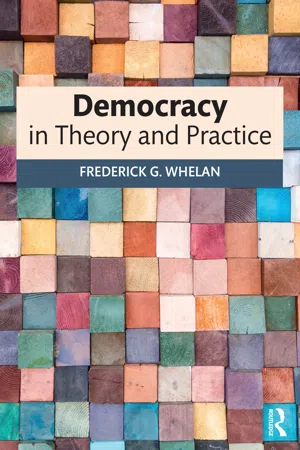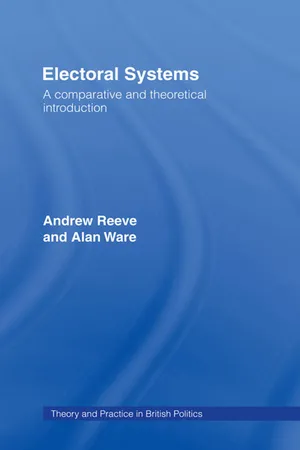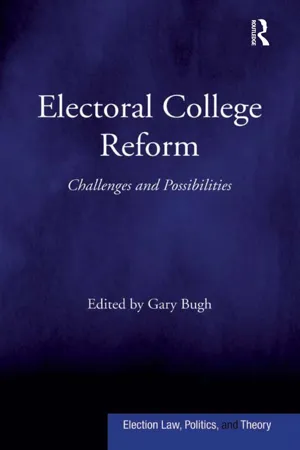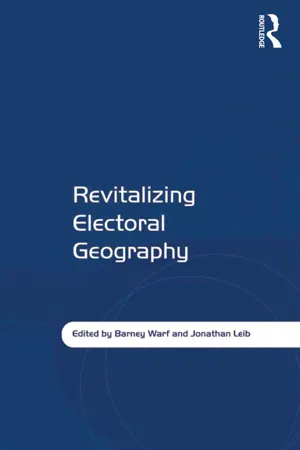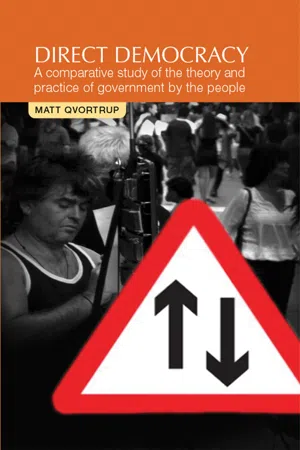Politics & International Relations
Alternative Vote System
The Alternative Vote (AV) system is a voting method in which voters rank candidates in order of preference. If no candidate receives an absolute majority of first-preference votes, the candidate with the fewest first-preference votes is eliminated, and their votes are redistributed based on the voters' next preferences. This process continues until a candidate secures a majority of the votes.
Written by Perlego with AI-assistance
Related key terms
6 Key excerpts on "Alternative Vote System"
- eBook - ePub
- Frederick G. Whelan(Author)
- 2018(Publication Date)
- Routledge(Publisher)
26(5) The alternative vote (also called instant runoff or ranked-choice voting in the US) has been used for the Australian House of Representatives, for presidential elections in Ireland, and for some municipal elections in the US (for example, San Francisco and Minneapolis); in a 2016 referendum, voters in Maine adopted ranked-choice voting for future state elections. A proposal to adopt the alternative vote for elections to the UK House of Commons, a potentially historic change, was defeated by referendum in May, 2011.27The alternative vote belongs to the class of preferential or rank-ordered voting methods, in which voters rank their preferences rather than simply voting for their first-choice candidate. One official or one member from each district is to be elected. Each voter casts one ballot on which he or she rank-orders his preferences among the listed candidates. A candidate receiving a majority of the first-choice votes is elected. If there is no outright majority winner, the candidate with the lowest number of first-choice votes is eliminated, and the second choices of those who ranked this candidate first are then counted and distributed to the remaining candidates. If this does not produce a majority, the second-choice votes of the candidate with the second-lowest number of first-choice votes are counted, and so on until one candidate has a majority and is elected.Like the runoff system, this method assures that winners receive majority support, although their majority may include some voters’ second preferences, and it takes into account the lower preferences of voters who support minor candidates and actually awards some of their votes to the winning candidate. Correspondingly, this method provides an incentive for leading candidates to campaign for second-choice votes, creating a degree of responsiveness to the concerns of small electoral groups. A practical political advantage of the alternative vote is that, like runoffs, it is largely immune to anomalies resulting from the spoiler effect or vote-splitting. The results of the alternative vote and a runoff are usually similar, although there is no guarantee in the former that one of the top two among first-choice candidates will be the eventual winner. This system is simpler than a runoff in requiring only a single ballot but more complicated in calling on voters to rank their choices. It also lacks a feature that makes true runoffs politically interesting—the period of time between the two rounds of voting during which further campaigning and negotiations can take place. Although it uses only a single ballot, the Alternative Vote System is complex in its method of computing results and therefore not as transparent as simpler systems, which may be considered a defect. It is also more demanding of voters, who must be sufficiently informed to rank all or many of the candidates in order to benefit from the options this system offers. - eBook - ePub
- Andrew Reeve, Alan Ware(Authors)
- 2013(Publication Date)
- Routledge(Publisher)
C would receive only three votes each.The Alternative Vote
This is the other system used in the preliminary example. It aims to produce a majority winner by examining the first preferences of the voters. If a candidate has an overall majority, he or she is elected; if not, the candidate receiving the least number of first preferences is eliminated, and votes cast in his or her favour are transferred to each voter's second-choice candidate. The process is repeated until someone achieves a majority. If it is necessary to eliminate several candidates, a particular voter's third or lower preference might be counted. This system does not take account of the ranking unless a candidate is eliminated, and it then accords the same status to a lower-preference vote as it does to a first-preference vote.Two-stage or ‘run-off’ systems
Urwin identifies a number of different examples of run-off systems; what they have in common is the need for a second round if no-one achieves a majority on the first round (1987b: 30). They differ in the stipulations attached to the qualifications to enter the second round - from the case in which only the top two candidates in the first round are allowed to proceed, guaranteeing (saving the case of a tie) that one will receive a majority of votes cast, to cases in which all previous contestants, and new ones, may enter the second round, which is then decided by a plurality.The single transferable vote
The STV combines some features of the alternative vote, in its elimination procedure, with the special feature of potentially redistributing some votes from candidates who are elected. It relies on defining a quota of votes which someone must receive in order to be elected. John Stuart Mill was a great admirer of what he referred to as 'Hare's scheme' (Mill 1910: 261-7); and Hare was proposing the use of a particular formula for determining the quota. Hare defined the quota as - eBook - ePub
Electoral College Reform
Challenges and Possibilities
- Gary Bugh(Author)
- 2016(Publication Date)
- Routledge(Publisher)
Computerized voting systems would compile all votes cast nationally, potentially consider voters’ second (and even lower) ranked choices, and declare as winner the most widely supported candidate. 6 Instant runoff voting is used to elect leaders of a few other nations, prompting it to be regarded as a “foreign import” with little appeal for Americans. However, some American cities—such as Cambridge and San Francisco—have adopted instant runoff voting, while others such as Minneapolis have passed legislation implementing it in 2009, enabling future empirical studies of its effects. Because participants in our study were highly concerned about the unanticipated consequences of adopting reforms whose effects had not been thoroughly investigated, they were reluctant to support instant runoff voting. 7 But there are theoretical and analytical reasons for believing that instant runoff voting may be better than either the current Electoral College or the popular vote system sought by proponents of the interstate compact. While no electoral system is clearly best universally and against any future innovations, instant runoff voting may better satisfy widely accepted criteria for evaluating electoral systems than the current or the popular plurality systems. It is in this sense that the next section of this chapter will argue that instant runoff voting is best. 5 See Schumaker and Loomis, “Reaching a Collective Judgment,” 192–95. The most prominent advocate of the instant runoff is FairVote, http://www.fairvote.org/irv/ - eBook - ePub
- Steven Hill(Author)
- 2015(Publication Date)
- Routledge(Publisher)
Support has been gained from the left and the right, from people like John McCain as well as Howard Dean. And it’s the right kind of reform for our country at this time. When asked whether our nation should do away with the existing two-party system, a clear majority of Americans say yes. Yet, our eighteenth-century electoral methods create and reinforce the two-party system. More modern methods such as IRV and others (to be discussed in chapter 4) are better suited for our twenty-first-century politics. HOW IRV WORKS Instant runoff voting simulates a series of runoff elections to produce a majority winner in a single election. At the polls, voters pick their favorite candidate, but they also may indicate their second (i.e., runoff) choice, and even another runoff choice, ranking them on their ballots as 1, 2, and 3. After the polls close, the ballots are counted in the following way. First, only the number one rankings on each ballot are counted. If a candidate receives a majority of first rankings, she wins, which is exactly the way we do it now. But if no candidate wins a majority of first rankings, then the “instant runoff” begins. The candidate with the fewest first rankings is eliminated, and a runoff round of counting occurs immediately. In this round each voter’s ballot counts for her or his top-ranked candidate still in the race. For supporters of the eliminated candidate, their ballot counts for their second choice; this is the runoff candidate they would support if forced to come back to the polls for a separate, two-round runoff. All the ballots are retallied, and if any candidate now has an overall majority of ballots (which includes voters’ first rankings as well as the second rankings—that is, runoff choices—from voters of any eliminated candidates), that candidate is declared the winner. If no one has a majority, we eliminate the next candidate with the least number of votes and redistribute the runoff votes - eBook - ePub
- Jonathan Leib, Barney Warf(Authors)
- 2016(Publication Date)
- Routledge(Publisher)
In this system (AV), rather than indicate first and second preferences only among the candidates, electors are asked to rank order them all. If a candidate gets a majority of the first preference votes, he/she is elected. If no candidate achieves the quota, however, the one with fewest first preferences is eliminated, and her/his second preferences allocated among the others; if one then exceeds the quota, the election is over. If no candidate still reaches the majority, the remaining one with fewest first preferences is eliminated and second preferences allocated – or third, if the second preference is for an eliminated candidate. The procedure continues until either one candidate reaches the quota or only two remain, in which case the one with most votes is elected. (This may not be a majority because some electors do not rank order all of the candidates.)The Alternative Vote System was pioneered in Australia in 1919 as a way of combining the votes for several right-of-centre parties that otherwise might lose an FPTP election to a single left-of-centre party’s candidate who failed to obtain a majority of the votes cast (McLean, 1996); it has been used since then for elections to the country’s House of Representatives, as well as to several of the state legislatures (Farrell and McAllister, 2006). It places considerably more demands on the voter than even SV, especially where there is a large number of candidates (in some Australian elections, electors have been asked to rank order more than 20 candidates in a single constituency). Although voters do not need to be prescient as to which the leading two candidates on the first preferences will be, some sophisticated decision-making may be needed to ensure that their votes are not wasted, especially if their first preference is for a party very unlikely to be elected in the constituency. Tactical voting can be very effective, especially at preventing the election of a candidate with substantial, but not majority, first preference support but, unlike FPTP, the system does not discourage people from giving their first preference to a candidate who will almost certainly lose.If the second and lower preferences are allocated, however, the order in which candidates are placed can be crucial – which is why Australian political parties distribute ‘how to vote’ cards to voters, suggesting a rank-ordering that is in their own candidates’ best interests by reducing the chances of their main contenders. - eBook - ePub
Direct democracy
A comparative study of the theory and practice of government by the people
- Matt Qvortrup(Author)
- 2015(Publication Date)
- Manchester University Press(Publisher)
7The British referendum on the Alternative Vote in comparative perspective
Under the electoral system, which this Clause proposes to set up [the Alternative Vote], no one is to have what he wants but everybody is to have their second preference. Why is a proposal of this kind brought before this House? It reminds me of a saying of Oscar Wilde regarding Whistler that: Whistler had no enemies, but he was intensely disliked by his friends. It would not be quite true to say that this Clause has no enemies; I am one, but it is true to say that it is intensely disliked by its friends.Sir Austen Chamberlain1The referendum is ‘nothing more and nothing else than a national veto’, noted A.V. Dicey.2 This might not be a full description of the uses (and abuses) of the referendum, but it is certainly one of its major functions.As we have seen in the other chapters, there are many claims as regards the beneficial effects of referendums. Likewise there are many idealistic descriptions of when referendums ought to be held. But the question is whether these are met in practice. Are referendums held for ideal reasons and are the outcomes always beneficial for democratic discourse? In Britain, where referendums and other forms of direct democracy are a rarity, some people have been less than impressed with the practical use of the referendum. The referendum on the Alternative Vote (AV) in 2011 is a case in point. Before reaching a verdict on the desirability or otherwise of a greater use of referendums – and indeed other forms of direct democracy – it may be instructive to study this recent British referendum.On 5 May 2011 a majority of 67.9 per cent of British voters rejected a proposal to change the electoral system from first-past-the-post to the Alternative Vote. The turnout was 42 per cent. In the wake of the referendum several questions were asked. How could the ‘yes’ Campaign, which had enjoyed a double digit lead in January 2010, lose by such a margin? Did the better-financed side win by virtue of deeper pockets? Was the result driven by cues from party leaders rather than based on enlightened decisions by the voters? And are referendums on electoral reform always unsuccessful?
Learn about this page
Index pages curate the most relevant extracts from our library of academic textbooks. They’ve been created using an in-house natural language model (NLM), each adding context and meaning to key research topics.
